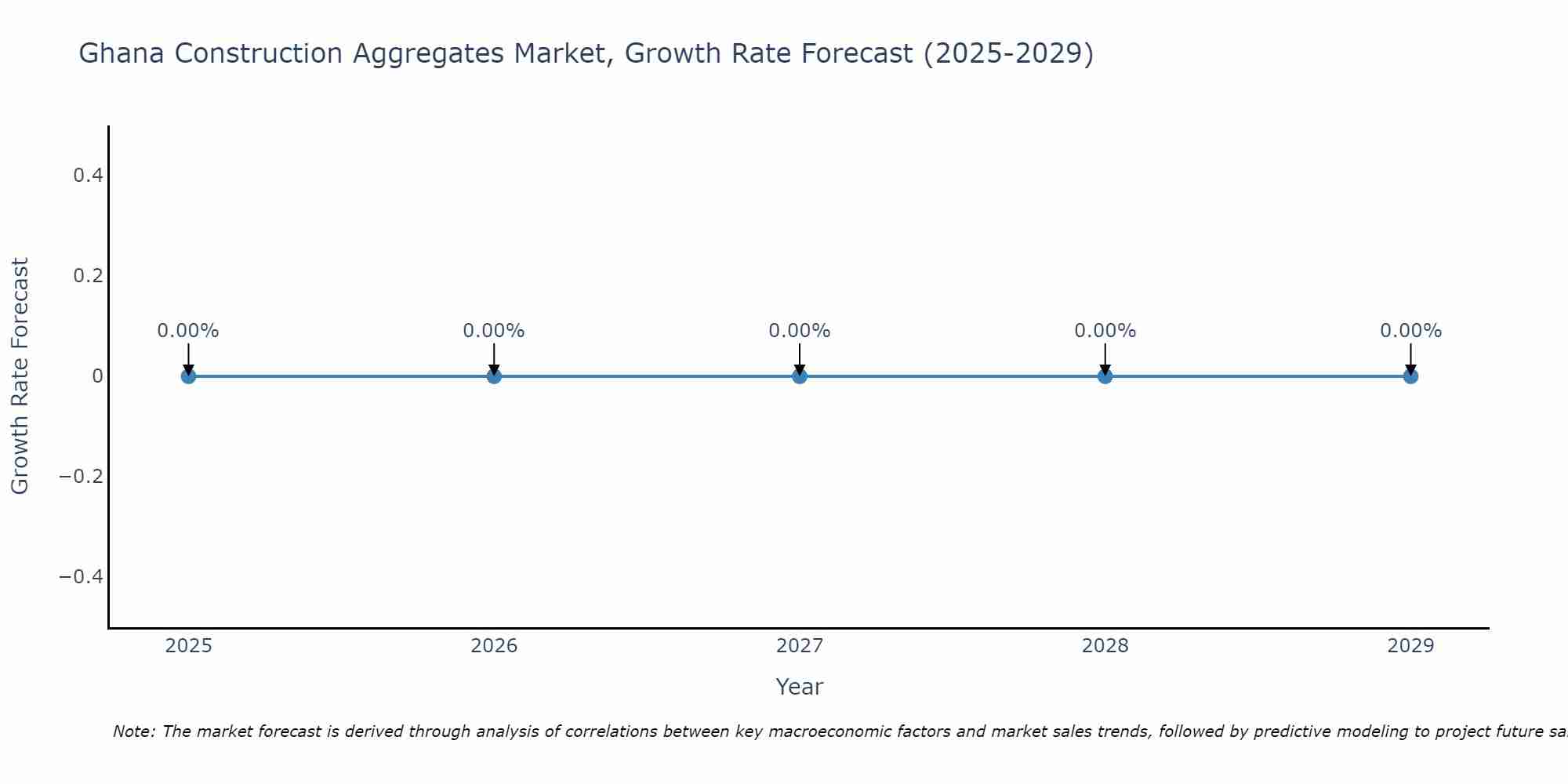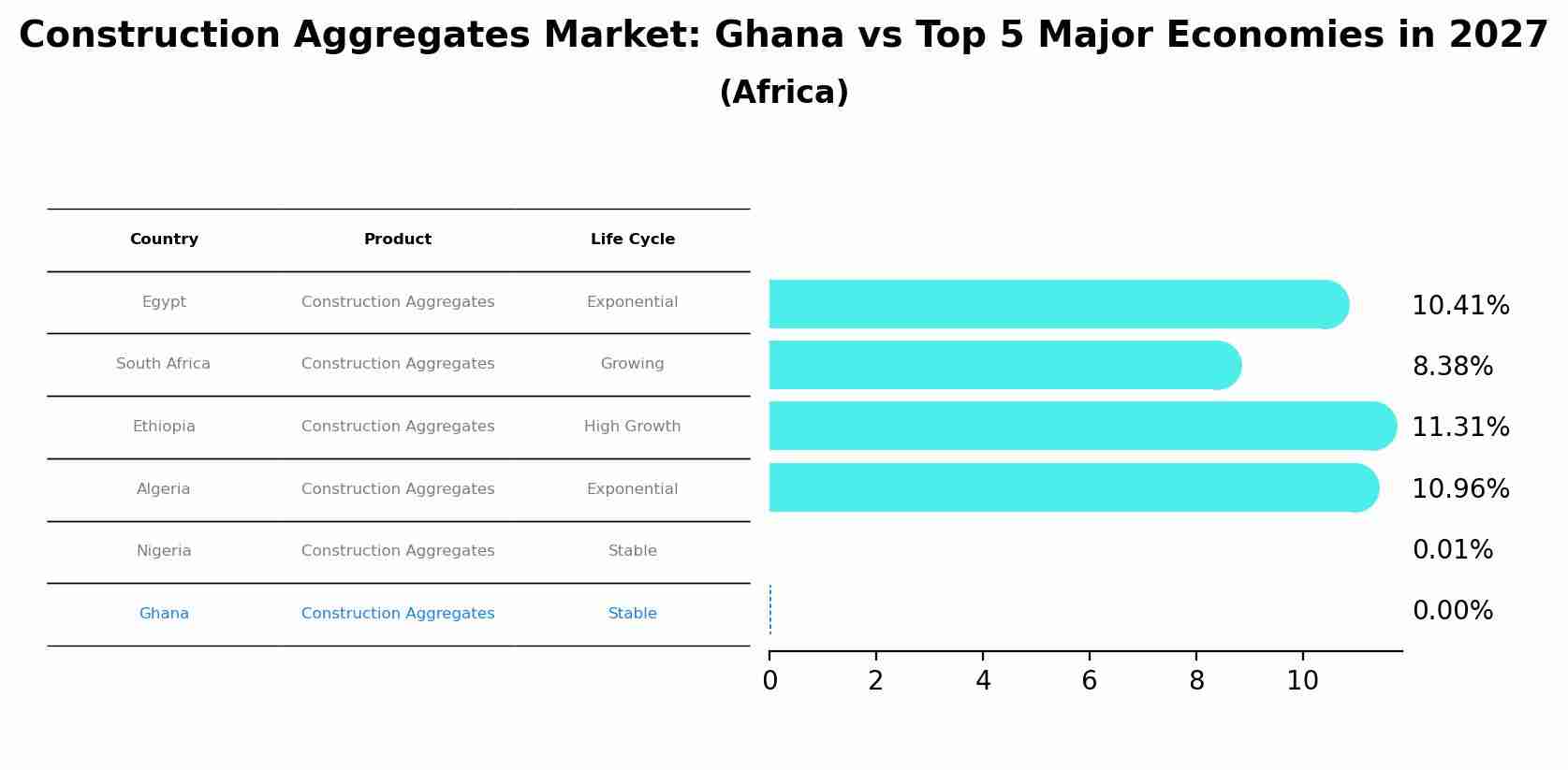Ghana Construction Aggregates Market (2025-2031) | Revenue, Share, Trends, Analysis, Companies, Forecast, Outlook, Industry, Growth, Value & Size
| Product Code: ETC048696 | Publication Date: Jan 2021 | Updated Date: Apr 2025 | Product Type: Report | |
| Publisher: 6Wresearch | Author: Ravi Bhandari | No. of Pages: 70 | No. of Figures: 35 | No. of Tables: 5 |
Ghana Construction Aggregates Market Size Growth Rate
The Ghana Construction Aggregates Market is likely to experience consistent growth rate gains over the period 2025 to 2029. The growth rate starts at 0.00% in 2025 and reaches 0.00% by 2029.

Construction Aggregates Market: Ghana vs Top 5 Major Economies in 2027 (Africa)
By 2027, Ghana's Construction Aggregates market is forecasted to achieve a stable growth rate of 0.00%, with Egypt leading the Africa region, followed by South Africa, Ethiopia, Algeria and Nigeria.

Ghana Construction Aggregates Market Overview
The construction aggregates market in Ghana provides essential materials such as sand, gravel, crushed stone, and recycled aggregates used in building, infrastructure, and civil engineering projects. Aggregates are key components of concrete, asphalt, and base materials for roads, bridges, buildings, and other structures. In Ghana, the construction aggregates market is driven by urbanization, population growth, and demand for residential, commercial, and public infrastructure development. Aggregate producers and suppliers in Ghana operate quarries, mines, and recycling facilities to supply high-quality materials that meet regulatory standards and project specifications, supporting sustainable and resilient construction practices.
Drivers of the market
The construction boom in Ghana, driven by infrastructure development projects and urbanization, is fueling the demand for construction aggregates. Aggregates such as sand, gravel, and crushed stone are essential materials in construction activities, driving growth in the construction aggregates market.
Challenges of the market
Challenges in the construction aggregates market in Ghana include environmental regulations and sustainability concerns related to quarrying activities. Moreover, infrastructure constraints and transportation costs may affect the availability and pricing of construction aggregates for infrastructure projects.
Government Policy of the market
Recognizing the importance of construction aggregates as essential materials for infrastructure development, the government may introduce policies to support the construction aggregates market. These policies could include initiatives to promote sustainable sourcing and production of aggregates, provide incentives for investment in aggregate extraction and processing facilities, and establish standards and regulations for aggregate quality, environmental impact, and community engagement. Additionally, the government may implement measures to support skills development and training in aggregate mining, processing, and transportation, facilitate access to financing and technical assistance for aggregate producers and suppliers, and promote collaboration between public and private stakeholders to address infrastructure needs and ensure responsible aggregate resource management.
Key Highlights of the Report:
- Ghana Construction Aggregates Market Outlook
- Market Size of Ghana Construction Aggregates Market, 2024
- Forecast of Ghana Construction Aggregates Market, 2031
- Historical Data and Forecast of Ghana Construction Aggregates Revenues & Volume for the Period 2021-2031
- Ghana Construction Aggregates Market Trend Evolution
- Ghana Construction Aggregates Market Drivers and Challenges
- Ghana Construction Aggregates Price Trends
- Ghana Construction Aggregates Porter's Five Forces
- Ghana Construction Aggregates Industry Life Cycle
- Historical Data and Forecast of Ghana Construction Aggregates Market Revenues & Volume By Product Type for the Period 2021-2031
- Historical Data and Forecast of Ghana Construction Aggregates Market Revenues & Volume By Crushed stone for the Period 2021-2031
- Historical Data and Forecast of Ghana Construction Aggregates Market Revenues & Volume By Sand for the Period 2021-2031
- Historical Data and Forecast of Ghana Construction Aggregates Market Revenues & Volume By Gravel for the Period 2021-2031
- Historical Data and Forecast of Ghana Construction Aggregates Market Revenues & Volume By Other aggregates for the Period 2021-2031
- Historical Data and Forecast of Ghana Construction Aggregates Market Revenues & Volume By Applications for the Period 2021-2031
- Historical Data and Forecast of Ghana Construction Aggregates Market Revenues & Volume By Commercial for the Period 2021-2031
- Historical Data and Forecast of Ghana Construction Aggregates Market Revenues & Volume By Residential for the Period 2021-2031
- Historical Data and Forecast of Ghana Construction Aggregates Market Revenues & Volume By Industrial for the Period 2021-2031
- Historical Data and Forecast of Ghana Construction Aggregates Market Revenues & Volume By Infrastructure for the Period 2021-2031
- Ghana Construction Aggregates Import Export Trade Statistics
- Market Opportunity Assessment By Product Type
- Market Opportunity Assessment By Applications
- Ghana Construction Aggregates Top Companies Market Share
- Ghana Construction Aggregates Competitive Benchmarking By Technical and Operational Parameters
- Ghana Construction Aggregates Company Profiles
- Ghana Construction Aggregates Key Strategic Recommendations
Frequently Asked Questions About the Market Study (FAQs):
1 Executive Summary |
2 Introduction |
2.1 Key Highlights of the Report |
2.2 Report Description |
2.3 Market Scope & Segmentation |
2.4 Research Methodology |
2.5 Assumptions |
3 Ghana Construction Aggregates Market Overview |
3.1 Ghana Country Macro Economic Indicators |
3.2 Ghana Construction Aggregates Market Revenues & Volume, 2021 & 2031F |
3.3 Ghana Construction Aggregates Market - Industry Life Cycle |
3.4 Ghana Construction Aggregates Market - Porter's Five Forces |
3.5 Ghana Construction Aggregates Market Revenues & Volume Share, By Product Type, 2021 & 2031F |
3.6 Ghana Construction Aggregates Market Revenues & Volume Share, By Applications, 2021 & 2031F |
4 Ghana Construction Aggregates Market Dynamics |
4.1 Impact Analysis |
4.2 Market Drivers |
4.3 Market Restraints |
5 Ghana Construction Aggregates Market Trends |
6 Ghana Construction Aggregates Market, By Types |
6.1 Ghana Construction Aggregates Market, By Product Type |
6.1.1 Overview and Analysis |
6.1.2 Ghana Construction Aggregates Market Revenues & Volume, By Product Type, 2021-2031F |
6.1.3 Ghana Construction Aggregates Market Revenues & Volume, By Crushed stone, 2021-2031F |
6.1.4 Ghana Construction Aggregates Market Revenues & Volume, By Sand, 2021-2031F |
6.1.5 Ghana Construction Aggregates Market Revenues & Volume, By Gravel, 2021-2031F |
6.1.6 Ghana Construction Aggregates Market Revenues & Volume, By Other aggregates, 2021-2031F |
6.2 Ghana Construction Aggregates Market, By Applications |
6.2.1 Overview and Analysis |
6.2.2 Ghana Construction Aggregates Market Revenues & Volume, By Commercial, 2021-2031F |
6.2.3 Ghana Construction Aggregates Market Revenues & Volume, By Residential, 2021-2031F |
6.2.4 Ghana Construction Aggregates Market Revenues & Volume, By Industrial, 2021-2031F |
6.2.5 Ghana Construction Aggregates Market Revenues & Volume, By Infrastructure, 2021-2031F |
7 Ghana Construction Aggregates Market Import-Export Trade Statistics |
7.1 Ghana Construction Aggregates Market Export to Major Countries |
7.2 Ghana Construction Aggregates Market Imports from Major Countries |
8 Ghana Construction Aggregates Market Key Performance Indicators |
9 Ghana Construction Aggregates Market - Opportunity Assessment |
9.1 Ghana Construction Aggregates Market Opportunity Assessment, By Product Type, 2021 & 2031F |
9.2 Ghana Construction Aggregates Market Opportunity Assessment, By Applications, 2021 & 2031F |
10 Ghana Construction Aggregates Market - Competitive Landscape |
10.1 Ghana Construction Aggregates Market Revenue Share, By Companies, 2024 |
10.2 Ghana Construction Aggregates Market Competitive Benchmarking, By Operating and Technical Parameters |
11 Company Profiles |
12 Recommendations |
13 Disclaimer |
- Single User License$ 1,995
- Department License$ 2,400
- Site License$ 3,120
- Global License$ 3,795
Search
Related Reports
- Vietnam System Integrator Market (2025-2031) | Size, Companies, Analysis, Industry, Value, Forecast, Growth, Trends, Revenue & Share
- ASEAN and Thailand Brain Health Supplements Market (2025-2031) | Strategy, Consumer Insights, Analysis, Investment Trends, Opportunities, Growth, Size, Share, Industry, Revenue, Segments, Value, Segmentation, Supply, Forecast, Restraints, Outlook, Competition, Drivers, Trends, Demand, Pricing Analysis, Competitive, Strategic Insights, Companies, Challenges
- ASEAN Bearings Market (2025-2031) | Strategy, Consumer Insights, Analysis, Investment Trends, Opportunities, Growth, Size, Share, Industry, Revenue, Segments, Value, Segmentation, Supply, Forecast, Restraints, Outlook, Competition, Drivers, Trends, Demand, Pricing Analysis, Competitive, Strategic Insights, Companies, Challenges
- Europe Flooring Market (2025-2031) | Outlook, Share, Industry, Trends, Forecast, Companies, Revenue, Size, Analysis, Growth & Value
- Saudi Arabia Manlift Market (2025-2031) | Outlook, Size, Growth, Trends, Companies, Industry, Revenue, Value, Share, Forecast & Analysis
- Uganda Excavator, Crane, and Wheel Loaders Market (2025-2031) | Strategy, Consumer Insights, Analysis, Investment Trends, Opportunities, Growth, Size, Share, Industry, Revenue, Segments, Value, Segmentation, Supply, Forecast, Restraints, Outlook, Competition, Drivers, Trends, Demand, Pricing Analysis, Competitive, Strategic Insights, Companies, Challenges
- Rwanda Excavator, Crane, and Wheel Loaders Market (2025-2031) | Strategy, Consumer Insights, Analysis, Investment Trends, Opportunities, Growth, Size, Share, Industry, Revenue, Segments, Value, Segmentation, Supply, Forecast, Restraints, Outlook, Competition, Drivers, Trends, Demand, Pricing Analysis, Competitive, Strategic Insights, Companies, Challenges
- Kenya Excavator, Crane, and Wheel Loaders Market (2025-2031) | Strategy, Consumer Insights, Analysis, Investment Trends, Opportunities, Growth, Size, Share, Industry, Revenue, Segments, Value, Segmentation, Supply, Forecast, Restraints, Outlook, Competition, Drivers, Trends, Demand, Pricing Analysis, Competitive, Strategic Insights, Companies, Challenges
- Angola Excavator, Crane, and Wheel Loaders Market (2025-2031) | Strategy, Consumer Insights, Analysis, Investment Trends, Opportunities, Growth, Size, Share, Industry, Revenue, Segments, Value, Segmentation, Supply, Forecast, Restraints, Outlook, Competition, Drivers, Trends, Demand, Pricing Analysis, Competitive, Strategic Insights, Companies, Challenges
- Israel Intelligent Transport System Market (2025-2031) | Strategy, Consumer Insights, Analysis, Investment Trends, Opportunities, Growth, Size, Share, Industry, Revenue, Segments, Value, Segmentation, Supply, Forecast, Restraints, Outlook, Competition, Drivers, Trends, Demand, Pricing Analysis, Competitive, Strategic Insights, Companies, Challenges
Industry Events and Analyst Meet
Our Clients
Whitepaper
- Middle East & Africa Commercial Security Market Click here to view more.
- Middle East & Africa Fire Safety Systems & Equipment Market Click here to view more.
- GCC Drone Market Click here to view more.
- Middle East Lighting Fixture Market Click here to view more.
- GCC Physical & Perimeter Security Market Click here to view more.
6WResearch In News
- Doha a strategic location for EV manufacturing hub: IPA Qatar
- Demand for luxury TVs surging in the GCC, says Samsung
- Empowering Growth: The Thriving Journey of Bangladesh’s Cable Industry
- Demand for luxury TVs surging in the GCC, says Samsung
- Video call with a traditional healer? Once unthinkable, it’s now common in South Africa
- Intelligent Buildings To Smooth GCC’s Path To Net Zero













